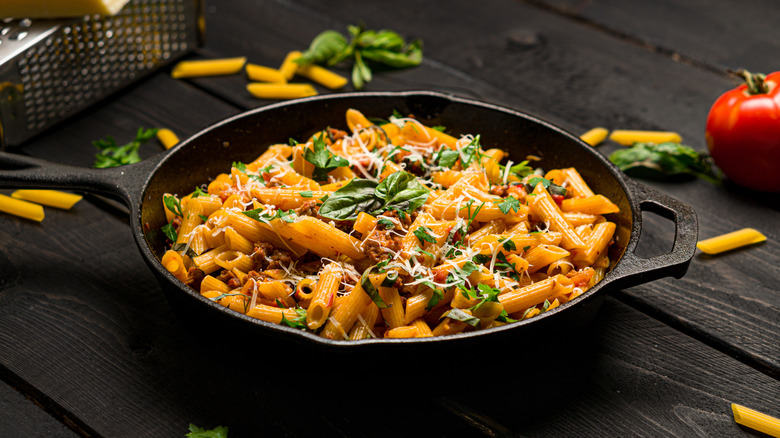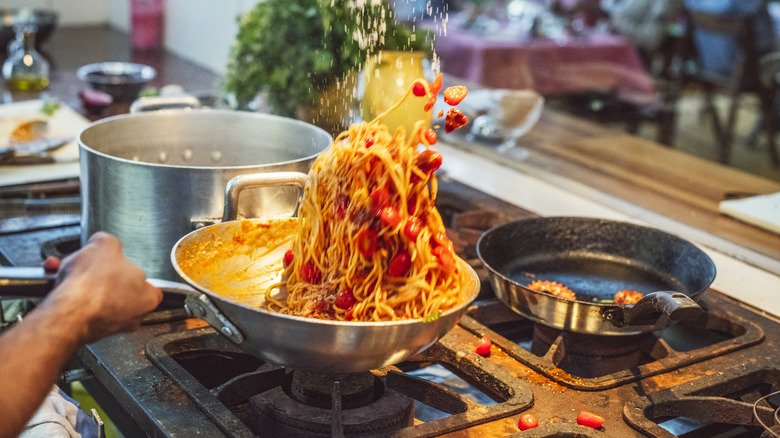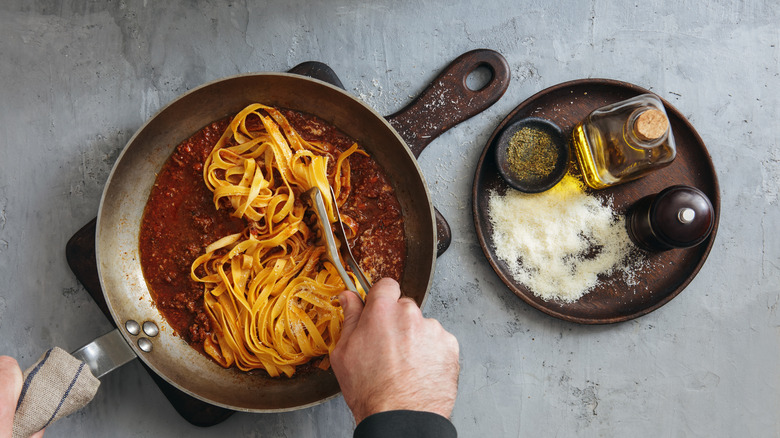The Dos And Don'ts For Cooking Pasta Directly In Sauce
One of the most important steps in making your homemade pasta stand up to your favorite Italian restaurant's pasta dishes is to combine the noodles and the sauce before the pasta is done cooking. Any Italian restaurant worth its salty pasta water will finish its pasta in the sauce before plating it up, and it's an easy way to amp up your pasta at home. So if finishing pasta in the sauce is good, is cooking it in sauce better? Sometimes! But not always.
If a sauce is too thick, it won't have enough water for the pasta to cook. You can thin it out, but you'll want to experiment with adding water, and carefully tend it as it cooks to make sure the water in the sauce doesn't evaporate before the pasta is done. You also need to have a skillet or pot big enough to submerge all your pasta in the sauce. If you don't, then boil the noodles separately to avoid uneven cooking, or stick with shorter noodles. Also, if your sauce shouldn't be simmered for 10 to 14 minutes, don't try to cook the pasta in it.
Cooking pasta in one pot or two?
There are sauces that shouldn't cook for as long as it would take to cook noodles: pesto, cacio e pepe, and carbonara being among them. At the same time, there are pasta dishes that have been specifically designed for it: pasta e ceci and one-pot pasta, for example. The sauces for these dishes are built in the process of cooking the pasta, and they have a much higher percentage of water at the beginning than a sauce would otherwise have because pasta needs a lot of water to cook.
Even when it's watered down, pasta cooks slower in sauce than in water. After a ton of testing, Serious Eats Senior Culinary Director Daniel Gritzer found that pasta removed from boiling water after six minutes and finished in sauce took a full four minutes longer to cook than pasta left in boiling water.
You'll notice that this recipe for one-pot spaghetti uses up to 6 cups of broth, reserving 2 to continually adjust the liquidity as it cooks. It also takes 15 minutes to cook the spaghetti instead of the eight to 10 it usually takes. If your sauce is already made, already the perfect consistency, and if you're in more of a hurry to get dinner on the table, finish the pasta in the sauce instead.
Finishing pasta in sauce
So what do you do if there are too many don'ts? If you can't cook your pasta directly in the sauce from the jump, you should still finish in it. The purpose of finishing your pasta in the sauce is to meld the two together. The starch of the pasta and its cooking water help the sauce to cling to the noodles. Without this step, the sauce won't stick to the pasta, unless you use sandpaper on your noodles.
To achieve perfectly sauced pasta, put some sauce in a skillet and bring it up to a simmer. Add your noodles a few minutes before they reach al dente, and thin the sauce with a ladleful of that starchy, salty pasta cooking water. Stir occasionally to keep the pasta from sticking to the bottom of the pan. Add more water as necessary, but keep checking the taste of the sauce — if it's getting too salty from the pasta water, switch to tap water. Finish cooking the noodles in the sauce until they're al dente.


